Has a Barometer Reading Ever Been Recorded for a Tornado. If So Then What Is the Reading.

Tornado intensity tin be measured by in situ or remote sensing measurements, just since these are impractical for wide-scale utilize, intensity is usually inferred by proxies, such as harm. The Fujita calibration and the Enhanced Fujita scale rate tornadoes by the damage caused.[ane] [2] The Enhanced Fujita calibration was an upgrade to the older Fujita calibration, with engineered (past adept elicitation) wind estimates and improve damage descriptions, but was designed so that a tornado rated on the Fujita scale would receive the same numerical rating. An EF0 tornado will probably damage trees and peel some shingles off the roof. An EF5 tornado can rip well-anchored homes off their foundations, leaving them blank, and tin can even deform large skyscrapers. The like TORRO scale ranges from a T0 for extremely weak tornadoes to T11 for the nigh powerful known tornadoes. Doppler radar information, photogrammetry, and footing swirl patterns (cycloidal marks) may also be analyzed to determine intensity and assign a rating.
Tornadoes vary in intensity regardless of shape, size, and location, though strong tornadoes are typically larger than weak tornadoes. The clan with track length and duration also varies, although longer track (and longer-lived) tornadoes tend to be stronger.[3] In the case of violent tornadoes, only a small portion of the path area is of violent intensity; virtually of the higher intensity is from subvortices.[4] In the The states, 80% of tornadoes are rated EF0 or EF1 (equivalent to T0 through T3). The rate of occurrence drops off quickly with increasing strength; less than 1% are rated as violent (EF4 or EF5, equivalent to T8 through T11).[five]
History of tornado intensity measurements [edit]
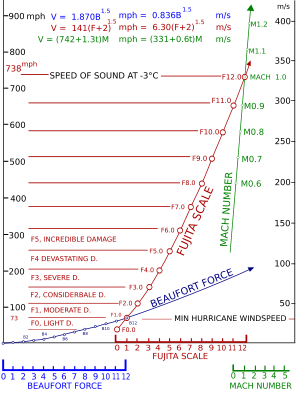
For many years, before the advent of Doppler radar, scientists had aught more educated guesses as to the speed of the winds in a tornado. The only evidence indicating the air current speeds found in the tornado was the harm left backside by tornadoes that struck populated areas. Some believed they reach 400 mph (640 km/h); others thought they might exceed 500 mph (800 km/h), and perhaps even be supersonic. One tin all the same notice these incorrect guesses in some old (until the 1960s) literature, such equally the original Fujita intensity scale developed by Dr. Tetsuya Theodore "Ted" Fujita in the early '70s. However, one tin detect accounts (e.chiliad. [1]; be sure to scroll down) of some remarkable work done in this field by a U.Southward. Army soldier, Sergeant John Park Finley.
In 1971, Dr. Fujita introduced the thought for a scale of tornado winds. With the help of colleague Allen Pearson, he created and introduced what came to be called the Fujita calibration in 1973. The F in F1, F2, etc. stands for Fujita. The scale was based on a relationship between the Beaufort scale and the Mach number scale; the low end of F1 on his calibration corresponds to the low terminate of B12 on the Beaufort scale, and the low end of F12 corresponds to the speed of sound at sea level, or Mach 1. In practice, tornadoes are simply assigned categories F0 through F5.
The TORRO scale, created by the Tornado and Storm Research Organisation (TORRO), was developed in 1974 and published a year later. The TORRO calibration has 12 levels, which embrace a broader range with tighter graduations. It ranges from a T0 for extremely weak tornadoes to T11 for the most powerful known tornadoes. T0–T1 roughly represent to F0, T2–T3 to F1, and then on. While T10–T11 would be roughly equivalent to F5, the highest tornado rated to date on the TORRO scale was a T8.[6] [seven] Some fence exists every bit to the usefulness of the TORRO scale over the Fujita calibration—while it may be helpful for statistical purposes to have more levels of tornado strength, often the damage caused could be created by a large range of winds, rendering it hard to narrow the tornado down to a unmarried TORRO scale category.
Research conducted in the late 1980s and 1990s suggested that fifty-fifty with the implication of the Fujita scale, tornado winds were notoriously overestimated, especially in significant and tearing tornadoes. Because of this, in 2006, the American Meteorological Society introduced the Enhanced Fujita scale, to assistance assign realistic air current speeds to tornado impairment. The scientists specifically designed the calibration and then that a tornado assessed on the Fujita scale and the Enhanced Fujita calibration would receive the same ranking. The EF-scale is more specific in detailing the degrees of harm on different types of structures for a given wind speed. While the F-scale goes from F0 to F12 in theory, the EF-scale is capped at EF5, which is defined as "winds ≥200 mph (320 km/h)".[8] In the United States, the Enhanced Fujita calibration went into effect on February ii, 2007, for tornado harm assessments and the Fujita scale is no longer used.
The first observation confirming that F5 winds could occur happened on April 26, 1991. A tornado virtually Red Stone, Oklahoma, was monitored by scientists using a portable Doppler radar, an experimental radar device that measures air current speed. Near the tornado'due south peak intensity, they recorded a air current speed of 115–120 m/s (260–270 mph; 410–430 km/h). Though the portable radar had uncertainty of ±v–ten m/s (xi–22 mph; eighteen–36 km/h), this reading was probably within the F5 range, confirming that tornadoes were capable of trigger-happy winds plant nowhere else on world.
Eight years later on, during the 1999 Oklahoma tornado outbreak of May 3, another scientific squad was monitoring an exceptionally violent tornado (one which eventually killed 36 people in the Oklahoma City metropolitan area). Around vii:00 pm, they recorded one measurement of 301 ± twenty mph (484 ± 32 km/h),[ix] 50 mph (fourscore km/h) faster than the previous record. Though this reading is just short of the theoretical F6 rating, the measurement was taken more than 100 ft (thirty m) in the air, where winds are typically stronger than at the surface.[ citation needed ] In rating tornadoes, only surface air current speeds, or the wind speeds indicated past the damage resulting from the tornado, are taken into account. Too, in do, the F6 rating is not used.
While scientists have long theorized that extremely low pressures might occur in the center of tornadoes, no measurements ostend it. A few dwelling house barometers had survived close passes by tornadoes, recording values as depression equally 24 inHg (810 hPa), but these measurements were highly uncertain.[10] However, on June 24, 2003, a group of researchers successfully dropped devices chosen "turtles" into an F4 tornado near Manchester, Southward Dakota, one of which measured a pressure drop of more than 100 hPa (3.0 inHg) every bit the tornado passed directly overhead.[xi] Still, tornadoes are widely varied, then meteorologists are all the same conducting enquiry to make up one's mind if these values are typical or non.
Typical intensity [edit]
In the U.s.a., F0 and F1 (T0 through T3) tornadoes account for fourscore% of all tornadoes. The rate of occurrence drops off quickly with increasing force—trigger-happy tornadoes (stronger than F4, T8), account for less than 1% of all tornado reports.[5] Worldwide, potent tornadoes account for an even smaller pct of total tornadoes. Fierce tornadoes are extremely rare outside of the The states, Canada, and Bangladesh.
F5 and EF5 tornadoes are rare, occurring typically in one case every few years. An F5 tornado was reported in Elie, Manitoba, in Canada, on June 22, 2007. Earlier that, the final confirmed F5 was the 1999 Bridge Creek–Moore tornado, which killed 36 people on May 3, 1999.[12] Nine EF5 tornadoes have occurred in the United States, in Greensburg, Kansas, on May four, 2007; Parkersburg, Iowa, on May 25, 2008; Smithville, Mississippi, Philadelphia, Mississippi, Hackleburg, Alabama, and Rainsville, Alabama, (iv dissever tornadoes) on April 27, 2011; Joplin, Missouri, on May 22, 2011, and El Reno, Oklahoma, on May 24, 2011. On May 20, 2013, a confirmed EF5 tornado again struck Moore, Oklahoma. [13]
Typical harm [edit]
| T0 | T1 | T2 | T3 | T4 | T5 | T6 | T7 | T8 | T9 | T10 | T11 |
|---|---|---|---|---|---|---|---|---|---|---|---|
| F0 EF0 | F1 EF1 | F2 EF2 | F3 EF3 | F4 EF4 | F5 EF5 | ||||||
| Weak | Potent | Violent | |||||||||
| Significant | |||||||||||
| Intense | |||||||||||
A typical tornado has winds of 110 mph (180 km/h) or less, is almost 250 ft (76 m) across, and travels a mile (one.6 km) or so before dissipating.[ commendation needed ] However, tornadic behavior is extremely variable; these figures represent just statistical probability.
Ii tornadoes that look almost exactly the same can produce drastically different effects. Also, ii tornadoes that look very different tin produce similar damage, because tornadoes class by several different mechanisms and too follow a lifecycle that causes the same tornado to change in appearance over time. People in the path of a tornado should never try to decide its strength as it approaches. Betwixt 1950 and 2014 in the Usa, 222 people have been killed by EF1 tornadoes, and 21 accept been killed by EF0 tornadoes.[xvi] [17]
Weak tornadoes [edit]
Around sixty-seventy% [xviii] of tornadoes are designated EF1 or EF0, also known equally "weak" tornadoes, only weak is a relative term for tornadoes, equally even these can cause significant damage. F0 and F1 tornadoes are typically curt-lived; since 1980, almost 75% of tornadoes rated weak stayed on the ground for ane mi (1.6 km) or less.[12] In this time, though, they can cause both damage and fatalities.
EF0 (T0–T1) impairment is characterized past superficial damage to structures and vegetation. Well-built structures are typically unscathed, though sometimes sustaining cleaved windows, with modest damage to roofs and chimneys. Billboards and large signs tin can exist knocked down. Trees may accept large branches broken off, and can be uprooted if they accept shallow roots. Any tornado that is confirmed, merely causes no damage (i.east. remains in open fields) is usually rated EF0, every bit well, even if the tornado has winds that would give it a higher rating. Some NWS offices, even so, have rated these tornadoes EFU (EF-Unknown) due to the lack of damage. [19]
EF1 (T2–T3) harm has acquired significantly more than fatalities than those caused by EF0 tornadoes. At this level, damage to mobile homes and other temporary structures becomes significant, and cars and other vehicles can exist pushed off the route or flipped. Permanent structures can suffer major harm to their roofs.
-
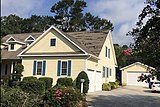
EF0 damage: This house only sustained small-scale loss of shingles. Though well-built structures are typically unscathed by EF0 tornadoes, falling trees and tree branches can injure and kill people, fifty-fifty inside a sturdy structure. Between 35 and forty% of all annual tornadoes in the U.Due south. are rated EF0.
-
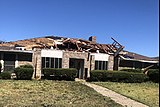
EF1 damage: Cause major damage to mobile homes and automobiles, and can cause minor structural damage to well-constructed homes. This frame habitation sustained major roof damage, only otherwise remained intact. Around 35% of all annual tornadoes in the U.S. rated EF1.
Significant tornadoes [edit]
EF2 (T4–T5) tornadoes are the lower cease of "significant", even so are stronger than most tropical cyclones (though tropical cyclones touch on a much larger area and their winds accept identify for a much longer duration). Well-built structures can suffer serious damage, including roof loss, and plummet of some outside walls may occur at poorly built structures. Mobile homes, yet, are totally destroyed. Vehicles can be lifted off the footing, and lighter objects can become pocket-sized missiles, causing harm exterior of the tornado's main path. Wooded areas take a large percent of their trees snapped or uprooted.
EF3 (T6–T7) damage is a serious risk to life and limb and the indicate at which a tornado statistically becomes significantly more than subversive and deadly. Few parts of affected buildings are left standing; well-congenital structures lose all outer and some inner walls. Unanchored homes are swept away, and homes with poor anchoring may collapse entirely. Pocket-size vehicles and similarly sized objects are lifted off the ground and tossed every bit projectiles. Wooded areas suffer almost full loss of vegetation, and some tree debarking may occur. Statistically speaking, EF3 is the maximum level that allows for reasonably constructive residential sheltering in identify in a first-floor interior room closest to the center of the house (the most widespread tornado sheltering procedure in America for those with no basement or hush-hush storm shelter).
-

EF2 damage: At this intensity, tornadoes accept a more significant impact on well-built structures, removing the roofs, and collapsing some exterior walls of poorly built structures. EF2 tornadoes are capable of completely destroying mobile homes, and generating large amounts of flying debris. This dwelling completely lost its roof, only its walls remained intact. Between 15 and 19% of all annual tornadoes in the U.S. are rated EF2.
-
EF3 damage: Here, the roof and all but some inner walls of this frame dwelling have been demolished. While taking shelter in a basement, cellar, or inner room improves ane's odds of surviving a tornado drastically, occasionally even this is not enough. EF3 and stronger tornadoes only account for about 6% of all annual tornadoes in the The states, nonetheless since 1980, they have deemed for more 75% of tornado-related deaths.
Violent tornadoes [edit]
EF4 (T8–T9) damage typically results in a total loss of the afflicted structure. Well-built homes are reduced to a short pile of medium-sized debris on the foundation. Homes with poor or no anchoring are swept completely away. Large, heavy vehicles, including airplanes, trains, and large trucks, can be pushed over, flipped repeatedly, or picked up and thrown. Large, healthy trees are entirely debarked and snapped off close to the ground or uprooted altogether and turned into flying projectiles. Passenger cars and similarly sized objects can exist picked up and flung for considerable distances. EF4 damage can be expected to level even the about robustly built homes, making the common practice of sheltering in an interior room on the ground floor of a residence insufficient to ensure survival. A storm shelter, reinforced basement, or other subterranean shelter is considered necessary to provide whatever reasonable expectation of safety confronting EF4 damage.
EF5 (T10–T11) damage represents the upper limit of tornado power, and destruction is almost always full. An EF5 tornado pulls well-built, well-anchored homes off their foundations and into the air before obliterating them, flinging the wreckage for miles and sweeping the foundation clean. Big, steel-reinforced structures such as schools are completely leveled. Tornadoes of this intensity tend to shred and scour low-lying grass and vegetation from the ground. Very little recognizable structural debris is generated by EF5 damage, with near materials reduced to a fibroid mix of pocket-sized, granular particles and dispersed evenly across the tornado's harm path. Large, multiple-ton steel frame vehicles and farm equipment are often mangled beyond recognition and deposited miles away or reduced entirely to unrecognizable component parts. The official description of this damage highlights the extreme nature of the destruction, noting that "incredible phenomena will occur"; historically, this has included such displays of power as twisting skyscrapers, leveling entire communities, and stripping asphalt from roadbeds. Despite their relative rarity, the damage caused past EF5 tornadoes represents a disproportionately extreme hazard to life and limb; since 1950 in the U.s.a., merely 59 tornadoes (0.1% of all reports) accept been designated F5 or EF5, and all the same these have been responsible for more than 1300 deaths and 14,000 injuries (21.5 and thirteen.6%, respectively).[12] [twenty]
-
EF4 damage: Brick home reduced to piles of rubble. Higher up-ground structures are almost completely vulnerable to EF4 tornadoes, which level well-built structures, toss heavy vehicles through the air, and uproot trees, turning them into flying missiles. Around i.ane% of annual tornadoes in the U.S. are rated EF4.
-

EF5 impairment: These tornadoes cause consummate devastation, obliterating and sweeping away well-nigh anything in their paths, including those sheltering in open basements. However, they are extremely rare (making up less than 0.1% of almanac tornadoes in the U.Due south.), and fifty-fifty a tornado rated as EF5 usually only produces EF5 damage across a relatively small portion of the damage path (with EF0-EF4 harm zones surrounding the central EF5 core).[21]
See too [edit]
- Tornado
- List of F5 and EF5 tornadoes
- Tornado records
- Wind applied science
References [edit]
- ^ NOAA: Fujita Tornado Damage Scale
- ^ Tornado Damage Scales: Fujita Calibration and Enhanced Fujita Scale
- ^ Brooks, Harold Eastward. (2004-04-01). "On the Relationship of Tornado Path Length and Width to Intensity". Atmospheric condition and Forecasting. 19 (2): 310–319. Bibcode:2004WtFor..nineteen..310B. doi:10.1175/1520-0434(2004)019<0310:OTROTP>2.0.CO;ii.
- ^ a b Grazulis, Thomas P. (July 1993). Significant Tornadoes 1680–1991. St. Johnsbury, Vermont: The Tornado Project of Ecology Films. ISBN978-one-879362-03-ane.
- ^ a b Edwards, Moller, Purpura; et al. (2005). "Basic Spotters' Field Guide" (PDF). Usa Department of Commerce, National Weather Service. Retrieved 2006-eleven-01 .
{{cite spider web}}: CS1 maint: multiple names: authors listing (link) - ^ Meaden, Dr. Terence (1985). "A Brief History of TORRO (to 1985)". TORRO. Retrieved 2006-xi-01 .
- ^ Diverse. "British Weather Extremes Summary". TORRO. Retrieved 2006-11-02 .
- ^ Edwards, Roger (2006-04-04). "The Online Tornado FAQ". Storm Prediction Heart. Retrieved 2006-09-08 .
- ^ Middle for Severe Weather Research (2006). "Doppler On Wheels". Archived from the original on 2007-02-05. Retrieved 2006-12-29 .
- ^ Lyons, Walter A. The Handy Weather Reply Book. Detroit: Visible Ink Press, 1997.
- ^ Chasing Tornadoes @ National Geographic Magazine
- ^ a b c Information from the Storm Prediction Heart archives, which are accessible through SvrPlot, free software created and maintained by John Hart, atomic number 82 forecaster for the SPC.
- ^ "F5 and EF5 Tornadoes of the U.s.a. - 1950-present (SPC)". www.spc.noaa.gov. Tempest Prediction Center. Retrieved 20 December 2021.
- ^ The Fujita Scale of Tornado Intensity Archived 2011-12-30 at the Wayback Auto
- ^ Severe Thunderstorm Climatology
- ^ "Search Tornadoes". Tornadohistoryproject.com. Tornadohistoryproject.com. Retrieved 24 June 2015.
- ^ "Climatological or By Storm Information and Archived Data." Storm Prediction Center. 2006.
- ^ "Tornado - Tornado intensity".
- ^ Murphy, John D. (nine July 2018). "National Weather Service Teaching x-1605" (PDF). National Weather Service. pp. A–74–75. Retrieved 6 March 2021.
- ^ http://www.norman.noaa.gov/nsww/wp-content/uploads/2012/03/LaDue_NSWW2012.pdf
- ^ WW2010 Project. "Tornadoes". University of Illinois at Urbana–Champaign Department of Atmospheric Sciences. Retrieved 2006-11-01 .
- Edwards, Roger; J. G. LaDue; J. T. Ferree; K. Scharfenberg; C. Maier; Due west. Fifty. Coulbourne (2013). "Tornado Intensity Estimation: Past, Present, and Future". Bull. Amer. Meteor. Soc. 94 (5): 641–53. Bibcode:2013BAMS...94..641E. doi:10.1175/BAMS-D-11-00006.one.
- Agee, Ernest; S. Childs (2014). "Adjustments in Tornado Counts, F-Calibration Intensity, and Path Width for Assessing Pregnant Tornado Destruction". J. Appl. Meteorol. Climatol. 53 (6): 1494–505. Bibcode:2014JApMC..53.1494A. doi:10.1175/JAMC-D-13-0235.one.
Further reading [edit]
- Feuerstein, Bernold; P. Groenemeijer; E. Dirksen; M. Hubrig; A.M. Holzer; N. Dotzek (Jun 2011). "Towards an improved wind speed calibration and harm description adjusted for Key Europe". Atmos. Res. 100 (four): 547–64. Bibcode:2011AtmRe.100..547F. doi:10.1016/j.atmosres.2010.12.026.
Source: https://en.wikipedia.org/wiki/Tornado_intensity
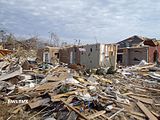
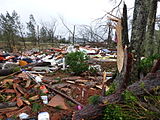
0 Response to "Has a Barometer Reading Ever Been Recorded for a Tornado. If So Then What Is the Reading."
Post a Comment